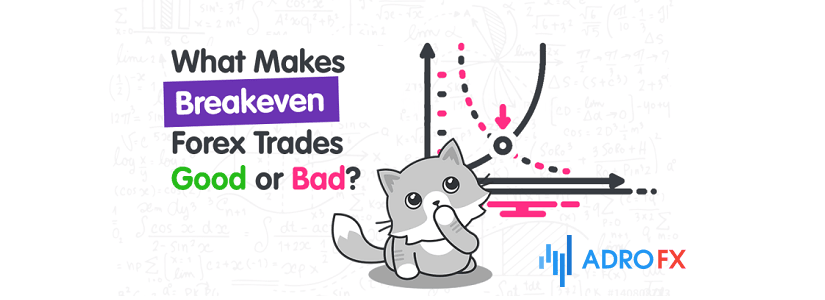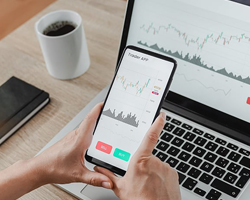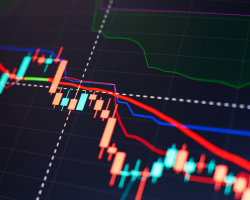Moving Stop Loss to Breakeven in Forex Trading

All traders on the forex market want to be successful. But how is this financial success evaluated? In most cases, we compare the size of incurred losses with the return value. However, this indicator by itself cannot be sufficient motivation. In case of a series of losing trades, we run the risk of falling into one of the psychological traps.
After a series of unsuccessful trades, the desire to gain some yield (to recoup losses) can become so strong that it will provoke more and more losses. This often leads to increased emotional tension, and trading based on emotions leads to large losses.
One of the ways to reduce emotional tension in trading can be moving the Stop Loss to breakeven.
What is Breakeven
To understand the concept of breakeven, we will use an illustrative example. Let's picture two situations in which, having analyzed the market and identifying the ascending channel, waiting for a test of the upper boundary and a bearish absorption reversal pattern, we will sell EUR/USD with targets near the lower boundary of the channel.
A successful entry into a short position, for some time, brought a return of about 12-13 pips, and the expectation of earnings increased, but instead of gain the price reversed and triggered the Stop Loss order. As a result, a position that has been showing some small gain has closed with a loss.
At the moment when the price has passed 12-13 pips, which is in fact more than half of the anticipated path from the point of order opening to Take Profit, we move Stop Loss below the opening price, thus securing our position from loss.
The further course of the price may be as follows:
- the price will continue to fall and reach a Take Profit order, securing gains;
- the price will reverse upwards and close the position by Stop Loss, not by a loss but by a gain.
We already know that in this case the price will choose the second option and prefer, not reaching Take Profit, to reverse upwards.
In the second case, one of the methods of trade support has been applied, namely moving Stop Loss to breakeven. Based on the above example, the description can be formulated as follows:
Breakeven level - transfer of the Stop Loss order of open trade to the beneficial area. Purpose: Exclusion of losses in the current trade.
The Psychology of Breakeven on Forex
The success of traders on 10% depends on trading strategies and 20% on money management. The remaining 70% of success is psychology and emotional balance, so trading is primarily a work on yourself. Breakeven can play the role of a stabilizer or a sedative in this situation, and everyone decides for himself whether he needs it or not.
Traders who do not move Stop Loss to breakeven, often want to "outbid" the market in a particular situation, forgetting about risk management. They forget that each trade is just an opportunity to attain yield, and a trader's success depends not on one trade, but the totality of all actions.
When you move a Stop Loss to a breakeven level, you do not put your trading account at risk, reserving the right to come back and trade again after some time.
Breakeven is very useful when the trade has good floating gains. This will help you keep your capital safe and avoid the unpleasant situation where a winning trade turns into a losing trade.
A breakeven level is just a tool you need to know how to use properly. Overly emotional traders can move their Stop Loss to breakeven too early, leading to a large number of "zero-out" trades. That's why you need to properly study this tool and the possibility of integrating it into your trading strategy.
In general, if your next trade turns out to be neither winning nor losing, take a break and rest for a while, because a result near-zero or closing a trade to breakeven turns out to be a positive result in the long run.
Why Do Traders Move Stop Loss to Breakeven?
The most basic reason is psychological. It's much more comfortable to keep a trade open if it can't result in a loss. Imagine it is a free return. You know that you will earn a good return or, in the worst-case scenario, you will break even.
The second reason is expert opinion. In practically all books on technical analysis, experts say that returns gained must be protected, and a breakeven stop is a great way to do this. And they are right. After all, for example, if you have 50 pips of gains, and then the price turns and goes in the opposite direction, as a result, instead of the lost return the trader gets an offensive Stop Loss. And that's a double blow to the trader. The first blow - the trader has lost funds. The second one is that the missed earnings syndrome will eat him from the inside, and the next time the trader may do something different, thus changing the strategy and worsening the mathematical expectation.
The third reason is greed and fear. It is when a trader moves a trade to breakeven as soon as it has become successful for a couple of ticks. Such breakeven losses are often taken out by the market and, by the law of meanness, the price moves in the right direction. As a result, many traders start to catch up with the price and rush in at a price much worse than the initial one. Fear and greed arise when a trader is unsure of his trading strategy and/or lacks confidence in himself. To become confident in terms of strategy, a trader should test the strategy on history for at least 3-6 months. And if during that period, the strategy showed a good result, the trader should not worry, trade according to the plan, and not be afraid of losses, because there will always be losses. With self-confidence, the situation is much more complicated, it will require a whole range of activities, from meditation to sports.
How Do I Correctly Set a Breakeven Level?
Often traders, especially beginners, rush to set breakeven as soon as the price passes the minimum number of points from the opening level. As a consequence, if the price fluctuates, the trade will be closed at Breakeven, after which the price continues to move in the desired direction. As a result, a potentially beneficial trade is closed without a loss, but without returns, and especially reckless traders hurry to reopen the position, but at a less favorable price, thereby increasing the trading risks.
Obviously, the breakeven level must be set correctly and on time. What does it mean? It is necessary to move trade to breakeven in such cases:
According to the rules of your trading system. That is, the transfer of trade to breakeven should be planned and put in the system.
A position should be moved to breakeven if the events do not develop according to the trader's scenario. For example, the trader enters with the expectation of an impulse or after a false breakout. But the price does not move and starts flat-lining, i.e., events do not begin to develop according to the planned scenario. Can a trade be placed to benefit in that case? Of course, you can. Because if the price begins to flat after the entry, price may start moving out of the mini consolidation in either direction and it is better to reopen the position under more clear conditions than to be in uncertainty. However, the time factor should be taken into account here. If you have made an entrance in the break between the European and American sessions, or the afternoon at one of these sessions, then the price for at least an hour can go into the channel, because in the market at this time there will not be active and large participants.
It is not necessary to move the trade to breakeven immediately after it has become advanatgeous. Price zigzags, so you need to give price some space and maneuverability.
There are no exact instructions on when to move the Stop Loss to the breakeven level. It depends on the volatility of the currency pair being traded, the time frame being used, and the type of trading. As a rule, each trader selects these levels independently, experimentally, using Fibonacci Retracement, fractals, Pivot levels, or any other technical tool.
Is it Worth Moving Stop Loss to Breakeven?
Trading at the exchange involves great risks. The trader has to make correct decisions all the time: when to secure gains? Should I wait more or this is the maximum for the price? What if I do not fix returns and a pullback occurs, then I will have nothing? Therefore, the question: "Should I move Stop Loss to breakeven?" is very important and requires very careful study.
Working with a breakeven level has two sides:
The front side of the coin states, by moving the Stop to breakeven, the trader will not lose anything (agree, this is just fine);
the other side of the coin says the price at any time can move to the breakeven level, knock out a Stop and go back to the anticipated level. The result of such a trade will be that you only break even, which is not the worst, but still not the best outcome. After all, we want to capitalize.
As a result, we are faced with a vital question: "Should we use breakeven or not, and if so, in what cases? Answering this question, it is necessary to understand that applying this strategy, and working with Stops is nothing else than a strategy of work, ironically reducing losses, but, more offensive, and gains, too.
So, a little experimentation will help you to understand this question. First of all, you should understand that different traders use different strategies that have different ratios of Stop Loss to Take Profit. If we have not omitted anything, we will try to mark out the main groups of traders:
Group #1. They work with Take Profit many times more and Stop Loss.
Group #2. They work with Take Profits that are lower than the Stop Loss.
Group #3. The SL/TP ratio of 1 to 1 (or close to it) is used in their work.
Let's analyze it in detail.
Group #1.
Traders of this group should not feel any evident benefit from the breakeven strategy. The matter is that their Stops are already very close and Stop Loss stands not just anywhere, but in a strategic area, where in their opinion the price should not reach.
Moving the Stop to the breakeven point would mean moving the level from the strategic area to a less comfortable one where the probability of being hit by a minor correction increases.
The conclusion suggests itself, that the use of breakeven will only be detrimental to this group of traders as it will not bring sufficient returns to be saved in a series of losses, but it will substantially reduce the gains due to an early exit.
Group #2.
For traders of this group, breakeven will mean that instead of taking the intended return, there will be many more closes on the breakeven with zero (or with a small return). After all, it should not be forgotten that this kind of trading involves leaving the price in the significant minus, and eventually moving to the Take Profit (used in the over-holding strategy).
Moving the stop to breakeven also does not make any sense. The strategy contains a Stop Loss set at a large distance, where the price is sure it will not reach. Using breakeven will increase the probability of closing many trades to zero and decrease the earnings potential.
Group #3.
In this group, traders use a Stop Loss to Take Profit ratio of 1 to 1, and working with breakeven looks much more promising.
Only properly using the Stop Loss method can increase the yield curve. Wait for the price to show a trend in the direction you are interested in, and only then move to breakeven. If you rush to breakeven, you increase the chance of losing a trade.
Dynamic Ratios
In the previous examples, we considered a knowingly calculated Stop Loss and Take Profit, but meanwhile, there are often systems that do not have a predetermined Take Profit level. In such strategies, usually, a trader tries to hold a position as long as possible.
In such cases, the use of breakeven, again, will not be superfluous and will provide indescribable assistance to the result. But, again, a trade closing should be used only when the price has already moved a significant number of points in the direction anticipated, corrected, and resumed the movement.
When using strategies in which the SL/TP ratio is 1 to 1 or Take Profit is dynamic, moving the position to breakeven is an excellent way to cut the loss, and if used correctly, the expected return will not suffer.
Disadvantages of Using Breakeven
Despite all the obvious benefits, applying breakeven still has several disadvantages:
- The more breakevens are triggered, the worse the mathematical expectation of winning.
- The more breakevens are triggered, the worse the statement is. This can play a special role if the trader demonstrates the results to investors. And if the trader has a large number of positions closed at breakeven, the investor may think that the trader is afraid to trade. In addition, it will be visible visually on the daily performance.
Statistically, a breakeven is triggered more often than an initial Stop Loss. For this reason, many traders prefer to close part of a position at the return level equal to the Stop Loss level.
Using Expert Advisors in Breakeven Approach
Yet it is not always convenient to move Stop Loss manually, and when working with forex Expert Advisors that place numerous orders, it is even physically difficult. Especially for extended work with automatic transfer of Stop Loss orders, there are special programs that will do that automatically.
This robot will not only help you to move one of the orders to the breakeven area but also the order grids opened manually or by another Expert Advisor. Such a robot can be suitable for any time frame or currency pair.
It can automatically calculate a breakeven level for trade and show the information in the upper left corner of the terminal screen. There you will find the name of the currency pair where the advisor was installed, the breakeven level where commissions are taken into account, the level of Stop Loss and Take Profit, and the number of pips the price must pass before the robot will place a Stop Loss.
Trailing Stop
And at the end of the article, we will consider one more variant of breakeven closure of the transaction: a trailing stop, which means that the order will follow the price at a certain distance. It is placed by right-clicking on the open position, the size is defined in points.
It is necessary to consider that the trailing stop will follow the price, while it moves in your direction, for example, you have bought a pair EUR/USD at the price of 1.0900 and have set the Trailing Stop on 50 points. The price has moved in your direction and is already at 1.1000 (you have gained +100 pips), if the price moves back 50 pips to 1.1050, your position will be closed (+50 pips). This type of order is convenient for medium-term trading or large market movements when you do not know when you can expect the end of the trend. If set correctly, the Trailing Stop allows you to take the maximum gain from the open position, but again, do not put it too quickly in volatile instruments, to avoid false closing of the position.
Conclusion
All in all, the main principle of a trader is not to make a loss. Do not forget about it, otherwise, payback will follow immediately. The essence of breakeven is to save your positions. In this case, you will not earn anything, but you will also not lose, which is not unimportant.
Breakeven in forex trading is a tool designed to protect your honestly earned return. However, if you think about it, this tool is quite controversial, because although the trader with it will protect himself from losses, in the end, he can lose his floating gain.
About AdroFx
Established in 2018, AdroFx is known for its high technology and its ability to deliver high-quality brokerage services in more than 200 countries around the world. AdroFx makes every effort to keep its customers satisfied and to meet all the trading needs of any trader. With the five types of trading accounts, we have all it takes to fit any traders` needs and styles. The company provides access to 115+ trading instruments, including currencies, metals, stocks, and cryptocurrencies, which make it possible to make the most out of trading on the financial markets. Considering all of the above, AdroFx is the perfect variant for anyone who doesn't settle for less than the best.









